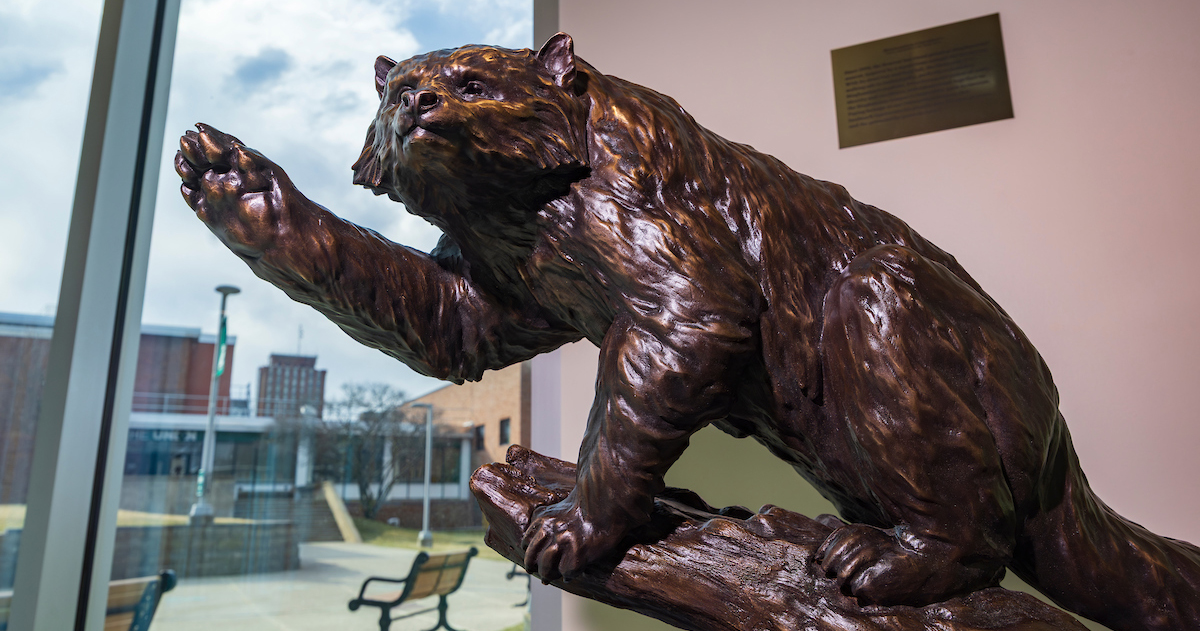Meet Bingturong: Binghamton University unveils new bearcat statue as focus for school pride
Interns for the Road Map Strategic Plan spearheaded the project, which aims to create new traditions on campus

Baxter the Bearcat has a new friend on campus.
On Thursday, Binghamton University unveiled a whimsical, life-sized statue of a binturong — the Southeast Asian mammal also called a bearcat — with its paw upraised and ready for high-fives.
The bronze statue, nicknamed Bingturong, marks 25 years since Binghamton adopted the bearcat as its mascot. For now, it is installed inside the Admissions building, but the plan is to move it to the Lois B. DeFleur Walkway — better known as the Spine — once renovations there are completed later this year.
Interns for the Road Map Strategic Plan organized the project over the past few years. President Harvey Stenger launched the Road Map initiative in 2013 to steer Binghamton to be the premier public university of the 21st century.
“The Bingturong statue is going to serve as a permanent symbol of the University community,” Stenger said. “It’s ferocious and competitive. It’s also playful and approachable, and I think it speaks to the attitude and the mindset of Binghamton’s students, faculty and staff. I’m also thrilled for the former Road Map interns. This was their vision, and they did tremendous work bringing this project to fruition.”
The proposal for the binturong, inspired by the similar Touchdown the Bear statue at Cornell University, came from former Road Map interns Nora Monasheri ’23, MBA ’24; Mia Raskin ’23, MBA ’24; and Daniel Chavarria ‘24 in 2023.
“I want to thank so many different people from campus who believed in us the whole way through,” Monasheri said at Thursday’s unveiling. “This idea would not have come to fruition if it wasn’t for you, especially President Stenger and his go-getter attitude.”
Road Map Internship Coordinator and Binghamton University Council Representative Mackenzie Cooper ’25, MPA ’26, sees Bingturong as a way to bolster Binghamton school spirit.
“We have such an amazing school, but sometimes we lack appreciation for that,” she said. “With this bearcat statue, we want to get everyone excited — maybe high-five the binturong for good luck on the way to class.”
The interns reached out to nearly 30 companies to ask about creating the statue, and they also visited a real binturong at an animal preserve to get a better idea what one looks like — a long body with short legs, a thick coat of coarse black hair, a bushy prehensile tail and large black eyes.
“The longest part was the design process,” said current intern Noah Hoch ’26. “We sent the statue-maker a little sketch and a photo, but we had to keep telling them, ‘Oh, we need more whiskers. We need the tail to be a little bit longer and the claws should be a little sharper.’ We also had to get approval from the Campus Appearance Committee and a couple other people. Everyone had their own opinion on it.”
The base of the statue is about 3 feet tall, with the statue itself about 2 to 3 feet tall.
“Five feet might not seem very high, but we want to make it accessible for all students to be able to high-five,” said intern Yejoo (Jay) Yong ’26. “If you’re in a wheelchair, you still can reach the paw.”
The interns hope the statue will become a cherished landmark on campus. Future Binghamton students may say “meet me at the binturong” or take photos there with their graduation caps and gowns.
One initiative for the Road Map internship program has been to get more students to attend athletics games. Teams could add a sports jersey to the statue on game days and set up a table to encourage passers-by to see them play.
Intern Sarah Zarember ’24, MBA ’25, also thinks the binturong statue celebrates Stenger’s legacy at Binghamton as he prepares to step down as president later this year.
“It means even more now than it did when it was proposed a few years ago,” she said. “This will be a really cool way of solidifying President Stenger’s impact on the campus. A piece of the incredible enthusiasm that he has for Binghamton University and how he tries to share that energy with the student body will live on past his tenure on this campus.”

